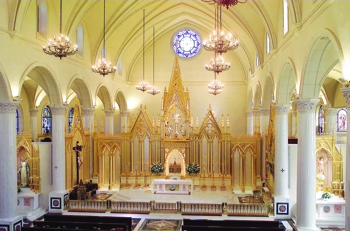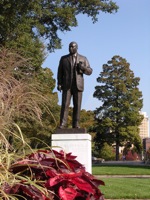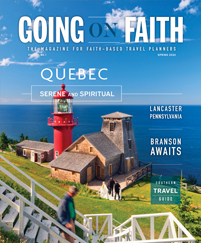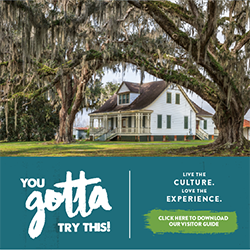
Vulcan has seen a lot in his time. For more than 100 years, he has stood watch over Birmingham, Ala., watching as the city underwent dramatic transformation through the course of the 20th century.
In Greek mythology, Vulcan was the god of the forge; in Birmingham, he is the larger-than-life statue that was erected in 1904 to symbolize the importance of steelwork in the city’s history. From toe to spear, the statue measures 56 feet and weighs in at more than 50 tons.
“Birmingham was once a big steel manufacturing town, and Vulcan is a part of that because he was cast here,” said Tara Walton, director of tourism for the Birmingham Convention and Visitors Bureau. “He’s the world’s largest cast-iron statue [of a man] and is second only to the Statue of Liberty.”
The massive statue is a great place to begin a group tour of Birmingham and to get some perspective on the city that was at the heart of the Civil Rights movement of the 1960s. Today, visitors will find that the spirit of that movement is still alive in the city, accompanied by a vibrant faith expressed in a number of creative ways.
A soul survivor
During the 1960s, Birmingham found itself in the national spotlight, as a number of tense situations made the city a flashpoint of the civil rights movement. One of the most remembered events was the bombing of the 16th Street Baptist Church, which killed four young African American girls in 1963.
 |
| Courtesy Birmingham CVB |
“We have a lot of visitors that come to experience the civil rights movement and to go to 16th Street Baptist Church,” Walton said. “Sixteenth Street is really what put everything out in the forefront. It’s the first time there was a massive loss of life with young people, and it placed us in the national spotlight.”
The bombing destroyed much of the church’s interior but left the exterior structure standing. After some reconstruction and refurbishment, the building remained an active house of worship; last year it also became a National Historic Landmark, and it now features a memorial exhibit for visitors interested in civil rights history.
“They never stopped having worship services over the years, even after the bombing,” Walton said. “Over the years, the church has done all that it can to reassure people that it’s a place to come reflect on the civil rights movement but also a place to come for reconciliation.”
Civil Rights District
From 16th Street, groups can proceed to Birmingham’s Civil Rights District. The area includes public memorials at Clay Engels Park, where some demonstrators were attacked with dogs and water cannons, and the Fourth Avenue business district, where many African Americans owned businesses that helped to fund the civil rights movement.
The Birmingham Civil Rights Institute gives visitors an overview of the city’s role in the greater civil rights movement.
 |
| Courtesy Birmingham CVB |
“The Civil Rights Institute really serves as an instrument that captures the spirit of the stories that took place in Birmingham,” Walton said. “There’s an introductory video that highlights the city’s history, along with connecting it to the heritage and the history of the civil rights movement.”
Murals and galleries throughout the museum show the conditions that Jim Crow laws created throughout the South. Exhibits show pairs of water fountains and school classrooms that were segregated, and demonstrate the disparate conditions and facilities available to the two races.
Some artifacts on display are especially poignant.
“There’s a gallery where you can see an actual cross that was burned in someone’s yard and an actual Ku Klux Klan outfit,” Walton said. “Once you enter the doors of the Civil Rights Institute, you’re going to be impacted by what you see.”
Jazz greats
Not far from the Civil Rights Institute, the Alabama Jazz Hall of Fame honors the likes of Duke Ellington, Lionel Hampton, W.C. Handy and Nat King Cole — all jazz luminaries who hailed from Alabama.
“The inductees are all Alabama artists with connections to the jazz world,” Walton said. “You have those artists, their memorabilia and what they contributed to the jazz world.”
Jazz memorabilia at the museum includes paintings, quilts, instruments and personal effects belonging to musicians such as Ella Fitzgerald. Also incorporated into the experience is the Carver Theatre, a historic venue built in 1935. Throughout the Jim Crow era, the Carver Theatre was the only place in town where blacks could go to watch movies. Today, it is part of the museum and is used for jazz performances and community events.
When groups visit the hall of fame, they are often guided by one of the museum’s founders, Frank Adams, who played with some of the great jazz artists of the big-band era.
“Frank comes out and serenades the group on his clarinet and talks about his experiences,” Walton said. “He talks about learning from Fess Whatley, a man who couldn’t read music but could play music very well.”
Pilgrimage trail
Beyond the civil rights attractions, the Birmingham area has a number of religious sites that the CVB promotes as a Catholic pilgrimage trail. Inside the city limits, groups can see the Cathedral of St. Paul, where they can tour the diocese or hold a meeting in the old Catholic schoolhouse on site.
North of the city, the Poor Clare nuns operate a pair of monasteries. At Our Lady of the Angels, groups can tour the monastery and learn about the nuns’ lifestyle, or have a service in the church. At another location west of Birmingham, groups can attend a taping of a television show for the Eternal Word Television Network, which was founded by one of the Poor Clare nuns.
Also nearby is the Ave Maria Grotto, which is home to a group of Benedictine monks and their collection of 125 models known as “Jerusalem in miniature.”
“The miniatures were put together over a number of years by one of the brothers that lived there,” Walton said. “He collected marble, pipes and coconut shells and used them to create these structures. You walk through the grotto and see these miniatures that range in height from 6 inches to 6 feet. It’s like a fairy land of different places that you would see in Israel.”
Seeking Guidance:
Greater Birmingham Convention and Visitors Bureau
(205) 458-8000
www.birminghamal.org









